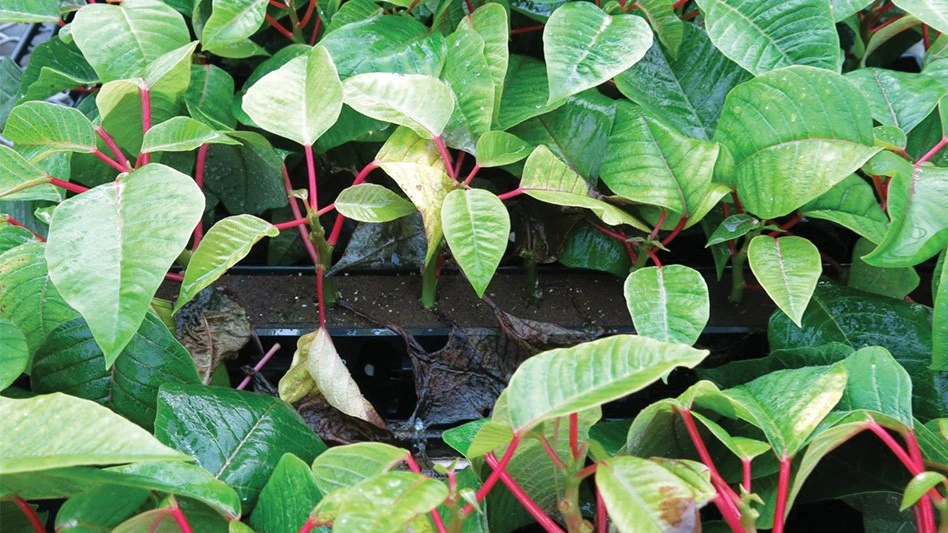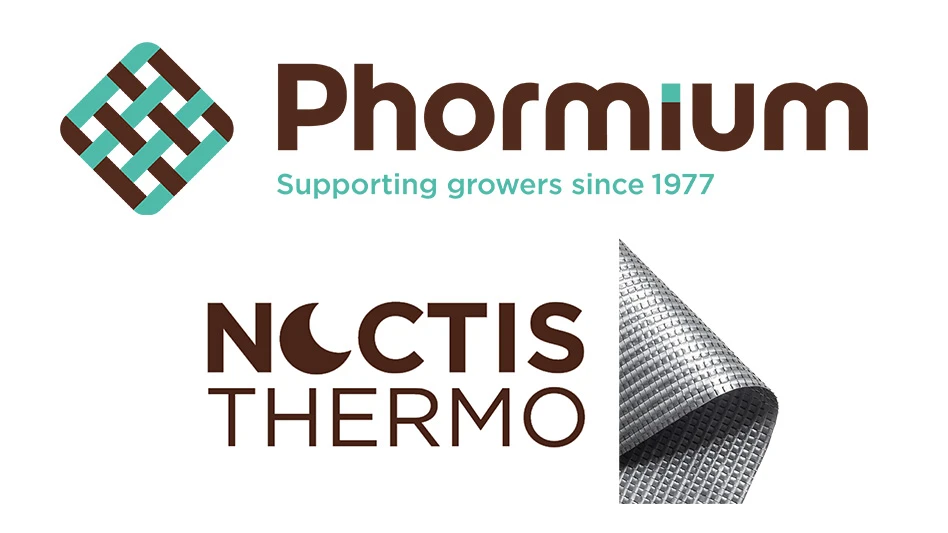


Growing poinsettias is not for the faint of heart. From sticking and pinching all the way to finish, this is one of the most labor-intensive crops. Coupled with a long production window, you have to keep your guard up so pests don’t gain a foothold and wreak havoc. Proper scouting and constant vigilance will help you to the finish line. A lot of relief and plenty of glory awaits you at the shipping bay, so let’s cover the hurdles you’ll likely encounter along the way.
Cuttings are the most vulnerable and unfortunately, they will likely be arriving under worst case scenario conditions. It’s prime summertime and temperatures both inside the greenhouse and on the loading docks are soaring. Heat is your worst enemy and you’re on a time crunch to get them stuck before they dry down or cook — but a little time is what you need to quickly inspect the cuttings as you stick them. Look for brown or black stems, water-soaked lesions or signs of rot. Throw away any suspect cuttings because diseases, especially bacterial soft rots, can quickly spread during propagation (Figure 1). We recommend you apply a preventive fungicide like Pageant® Intrinsic® brand fungicide at sticking and then again two weeks later to protect plants from diseases like Botrytis blight, leaf spots and even Rhizoctonia stem rot. Pageant Intrinsic brand fungicide also provides plant health benefits, including faster callous formation and improved rooting. Get poinsettias ready for the long-haul with a strong root system from the start.

Pythium root rot is the silent killer of poinsettias and oftentimes goes unnoticed until it’s too late. Stunting and chlorosis are early symptoms of disease, but these can easily be overlooked or mistaken for nutritional deficiency (Figure 2). As disease progresses, plants wilt during the heat of day but can recover overnight. Roots will appear brown, rotted and even water soaked or slimy. The outer cortex easily sloughs off. If plants are infected fairly early in production, root systems will be severely compromised and practically non-existent when you pull the plant from the pot. Eventually, diseased plants stay permanently wilted and die. The first fungicide drench at transplant is your most critical — so make sure it’s a good one. For best control of Pythium root rot, make sure you include Pythium-specialists in your rotation. Unfortunately, your options are few and far between and widespread resistance to mefenoxam further narrows down the list. Research conducted at North Carolina State University showed that over 50% of Pythium isolates collected from commercial greenhouses were resistant to the active ingredient mefenoxam and often facilities had a mix of both resistant and sensitive strains. The most effective active ingredients in university efficacy trials include cyazofamid, etridiazole, mefenoxam and fenamidone. We recommend you start your Pythium rotation with a tank mix of Empress® Intrinsic® brand fungicide plus Segway® O fungicide at transplant (Figure 3). Empress Intrinsic brand fungicide provides plant health benefits like increased rooting and protects against Rhizoctonia diseases — we see better control and better root systems with the tank mix compared to solo applications. If you opt to include mefenoxam (Subdue Maxx® fungicide) in your rotation, always tank mix with another mode of action to reduce the risk of fungicide failure caused by insensitive or resistant strains. Sanitation is your friend. Pythium, like other oomycetes, produces motile, swimming spores called zoospores. Therefore, it can move through irrigation and runoff water and spread to nearby plants. Throw away diseased plants as soon as possible because they will not recover and only serve as a source of inoculum for new infections. If you use recirculating or ebb-and-flow irrigation systems, make sure your filtering and treatment processes are working properly — Pythium can become a permanent resident in ponds and irrigation reservoirs.
Poinsettias face the same insect pressures in propagation as other color crops and coming into the finish stage management can get challenging. Coloring bracts are sensitive and prone to residue from chemical applications. Additionally once plants are being spaced to fill out the canopies, they’re more susceptible to injury from dry down — just when insect and mite populations tend to boom.

The best defense is a good preventive program that anticipates the challenges of getting to finish with unblemished plants. Start with your foundational weekly applications that include good biologicals like Nemasys and Millenium beneficial nematodes to manage fungus gnats, Western flower thrips and shore flies, and Velifer fungal contact insecticide for aphids, whiteflies, mealybugs, scale and mites. This trio creates a base for the other IPM tools. For the eight-legged part of your program (mites), add in and rotate miticides like Sultan miticide and Tetrasan. For the six-legged part of your program (insects), add in Ventigra insecticide, Mainspring, Azatin O, Distance or Fulcrum IGR. Ultra-Pure Oil is another tool to consider for mechanical management of all the arthropod pests and powdery mildew; this highly refined oil can be used when temps are below 85° F and relative humidity is under 85%. Note that oils will shine bracts up, so you’ll want to use oil applications in mid-season, prior to entering the later stages.
As you approach finish and spacing out, depending on greenhouse temperatures, you may need to tighten your intervals. Make applications preventively to avoid rescue applications, the risk of injury right before shipping, and issues with residues. Products like Nemasys, Millenium, and Velifer leave no residue on colored bracts (Figure 4). Products like Sultan and others with a whitish cast can be managed with the plant-safe adjuvant of your choice. In any case, pay particular attention to plants that are droughty as these will be sensitive to chemical applications.


Explore the August 2022 Issue
Check out more from this issue and find your next story to read.
Latest from Greenhouse Management
- This month's Greenhouse Management magazine is about native plants and sustainability
- The HC Companies, Classic Home & Garden merge as Growscape
- Terra Nova releases new echinacea variety, 'Fringe Festival'
- Eason Horticultural Resources will now officially be known as EHR
- BioWorks receives EPA approval for new biological insecticide for thrips, aphids, whiteflies
- ScottsMiracle-Gro transfers cannabis subsidiary to focus on core lawn and garden business
- Should we start calling natives 'eco-beneficial plants'?
- Ellen Mackenbach-Lakeman appointed new CEO of Dümmen Orange








